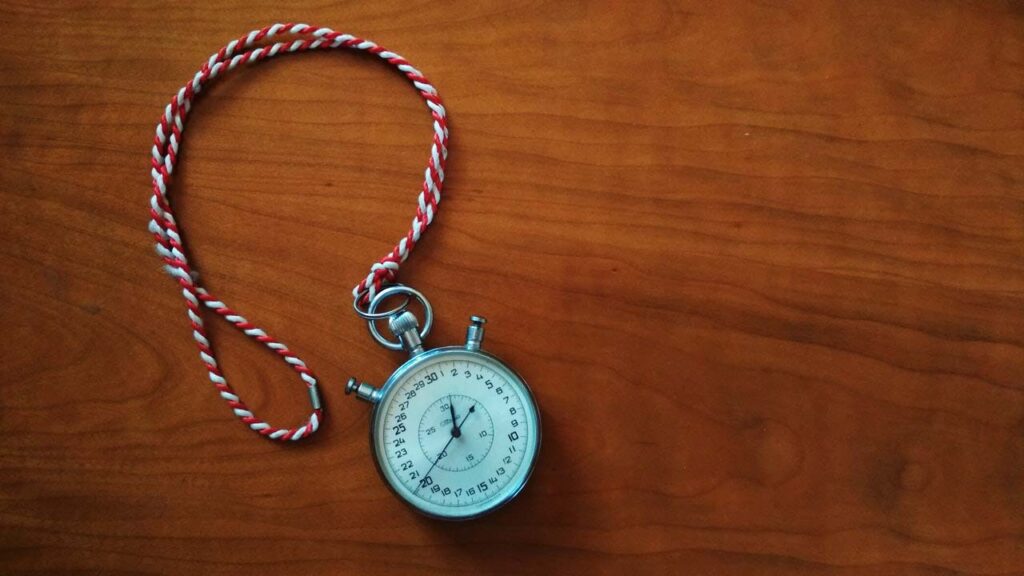It may seem hard to work under pressure. Still, it is something anyone can do with some basic level of training. In this brief guide, you will find several tips on how to work under pressure effectively and some common wisdom I witnessed with my own experience.
Defining Work Under Pressure
Before we can even think about strategies to work under pressure, we should clearly define what we mean by it. While it may be obvious at a high level, it is important to pin down a specific definition.
To work under pressure is to operate at or near maximum capacity for extended periods of time, thus having no slack to recover. It means having no room for error.
This definition clearly states what I mean and our concept of working under pressure that I will address throughout the article. Before continuing, however, let’s break it down.
Operating “at or near maximum capacity” means you are employing all or almost all the time you have available. Say, for example, you need 2 hours to produce a presentation and you have an 8h working day. If you need to do 4 presentations per day, then you are operating at capacity because you maxed out your time available.
Yet, maxing out capacity is not the only requirement to be under pressure. If you reach your capacity just one day, or one day per week or so while the others are less crunched, then you can rearrange some work or just put some more hours for once. The problem comes when you are constantly at capacity for extended periods: in this case, you have no mean of adding more time or shift tasks to other days.
This is what I mean with “no slack to recover”. If a task slips out of your hands today, you won’t have any opportunity to recover it tomorrow because by then you will have other tasks that you need to attend that drain your time. Because of this, you have no room for error.
This is to work under pressure.
How to Work Under Pressure Effectively
Many guides to work under pressure you will find online contain just no-brainer advice that is so obvious you are probably already doing. Even prominent websites such as Forbes list tips like “Don’t procrastinate”, like this was something people do intentionally, or “expect the unexpected”. Here, I want to get more serious.
The following tips will help you work under pressure effectively. This is what I personally do to manage my significant workloads. In fact, those tips derive directly from my experience. Specifically, I have been using these practices to be effective at two of the main things I do in my 65h work week:
- Lead 50+ people in various teams on a large-scale cybersecurity project for a manufacturing company, directly commissioned by the board of directors elected by stockholders
- Run a web agency and coordinating with several freelancers to ensure all customers get the best experience and always on time
I don’t think my feats are exceptional. What I think is that they will be much harder to achieve without these strategies I put in place to work under pressure.
1. Develop Weekly Plans
When I work under pressure, I often don’t have time to think. If I have to think what to do next, I can get out of the “flow state” of being extremely productive and then need some time to pick up that speed on the next task. In other words, as soon as I start working, I want to just execute and get things done, and thinking what to do next is a distraction.

To counter that, every Sunday I plan my calendar with one to-do list for each day all the way to the next Sunday. I do this in Microsoft OneNote, and you may find it helpful to read my full approach that includes concepts of lean management such as backlog.
I keep these to-do lists purposefully separated from my calendar appointments, because calendar appoints will just get done (because they are planned for a specific date and time). Instead, those are tasks to be tackled in my “time alone”, outside of meetings with other people.
All of this allows me to do a task and then just pick the next, without having to think much. If one day I am doing great and I finish early, I can start to pick up tasks from other days or even from the backlog (tasks that I know I must do at some point, but that are yet to be planned for a specific date).
2. Set Weekly Targets
Planning daily tasks is not enough if you want to work under pressure. This is because you risk of falling in the fallacy of “busyness”, doing many things to feel productive, while many of them are worth very little on the long term.
To avoid that, before starting to define the tasks I will do each individual day in my Sunday planning session, I define the targets for the entire week. Those are the accomplishments I want for the coming week in general, without binding them to any specific date. They should be something bigger than something you can do in a single day, and that probably require multiple tasks to complete. Ideally, you should have 2-3 of those every week, you could even stretch to 5 but this might become challenging.

Once you define your targets, you can outline your tasks and to-do lists starting to list all the activities you need to do to reach those targets. Only after that you can put in other activities. If there are other activities that do not work toward your targets but that you have to do, you may want to set less ambitious targets for this week.
All of this takes time, and every Sunday I spent between 30 to 60 minutes to review my weekly schedule. It is not something you can just get done on the sidelines; you need to allocate time to define a proper plan every week. So, the first thing you have to do to improve your capability to work under pressure is to set one hour per week to plan your week.
If you are already doing that, I encourage you to read my article on how to use OneNote for planning if you haven’t already because it is not the usual to-do list.
3. Measure
In the end, when you work under pressure you have just a capacity problem: you are working at your limit in terms of time available. According to the “theory of constraint”, to produce anything (a product, a service, an idea) you need resources (time, money, equipment, people etc.), and you should focus your attention managing carefully the most constrained resource.
When you work under pressure, your more constrained resource is time. You should find ways to reduce the constraint on time. To state the obvious, there are two ways to reduce this constraint:
- Reduce the time already allocated to activities, effectively carving some time back
- Increase the total amount of time available that you can allocate
Everyone has 24 hours in a day. Health is something that must never be sacrificed, so we need to account 8h to sleep and about 3h for eating, leaving us with a total of 13h per day. I would say nobody can go beyond that amount of work consistently. This means we are all capped at 13h per day (which is actually very hard to achieve). If you are already near this, there is nothing you can do to increase the amount of time available. You need to reduce the time consumption of the activities you are doing.
On top of this, I discourage working all the waking time. Working is a way to exploit your skills, and you should develop them as well. So, you should find time to learn during your week, and potentially do some fitness activities as well as some recreational activities.

It is much more practical to reduce the demands on your time. There is an actionable way to do this, which is to measure everything that you do with military precision. For this, you will need a timer (an app will do) and a spreadsheet, such as Excel.
Your spreadsheet should be a simple table with four columns:
- Date
- Project/item you worked on
- Brief description of what you did
- Amount of time worked in minutes
Every new day you add at least one new row to the table, depending on how many activities you did and how many projects you worked on. For example, if on a given day you work on project A and project B, you will need to have two lines.
Yes, amount of time worked in minutes means you have to track with your timer how much time you are working on each item.
It is evident that is extensive level of reporting will consume some of your time as you have to keep track of everything. Yet, it will produce valuable insight on how you are allocating your time and what are the projects or items that are draining your time the most. Already after one or two weeks, you can create a pivot table to see the amount of time allocated each week to each task.
You can even go full-blown on this and log all the activities you do, including house chores for example. Nonetheless, it is crucial that you use an actual timer to track your efforts, not just an estimate “I think I spend 90 minutes on this”.
Some people may be put off by this almost obsessive way of reporting. I think if you want to work under pressure at extreme levels, and achieve at extreme levels, this is what it takes. You don’t have to do this forever, but at least at the beginning to see how you allocate time (and again when there is a major shift in the things you do).
4. Cut back on waste
Cutting back on waste is a mantra of the lean philosophy and we can apply it to a work under pressure context as well. To do this, you need to execute the “measure” step first.
Once you have your data in front of you, you need to look at two key items:
- What are the activities draining most of your time each week?
- What activity seems to take too long individually (e.g., 4h to mop the floor sounds a little too much).
For the first case, you need to consider if you can reduce the amount of time you do those activities, for example delegating them or not doing them altogether. For the second case, you need to learn how to be more efficient in those activities.

Some other online guides on how to work under pressure give unpractical tips like “delegate” like you had an army of secretaries that could compete with the staff of the President of the United States. I think it is important to be more realistic and realize that, even when you work under pressure, it is not always possible to delegate. You might not have the apparatus to delegate activities to, or some activities just can’t be delegated (if you have to go to the dentist, you can’t send someone on your behalf).
I think delegating is in general a tradeoff between time and money. For some of the most basic activities you can pay someone or some company to do things on your behalf. If it is worth for your or not, it depends on how you value your time (and no, it is not necessarily your hourly rate, it is much more subjective). If you are in an urban area, you probably have the possibility to delegate: housekeeping, meal preparation, and laundry. Those are pretty “standard” tasks you don’t have to teach anyone how to do, and there are plenty of providers offering those services.
Other more personal and productive tasks may be harder to delegate. Instead of delegating, I suggest you to explore just completely drop some tasks. That is, not doing them, period. You now have your weekly targets and you are accustomed to work under pressure. Try not to do the tasks that don’t move the needle for your weekly targets for a week or two. Is everything fine? Probably, it will be.
Sometimes, the key to do more is to do less (of the unnecessary things). The hard part is be willing to let go and take the “leap of faith”.
Work Under Pressure in Summary
To work under pressure is not an easy feat, but with the correct training and discipline anyone can achieve it. In the end, working under pressure is all about pushing yourself slightly out of your comfort zone, and keeping you there. It won’t take long before you are accustomed to your new posture and can push yourself even a little further. Before you know it, you will be able to manage more and more pressure with no concern.
Of course, we could write books on how to work under pressure. But for effectiveness, I think here I covered everything that you need to know to get you up to speed. I hope you can find the same value I did from these practices.
Bonus tip: If you are serious about working in a hard environment and under pressure, I cannot suggest more the Extreme Ownership book by Jocko Willick. If you don’t know what I am talking about, take the time to watch this TEDx.